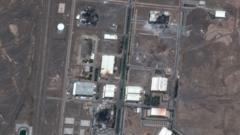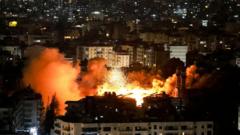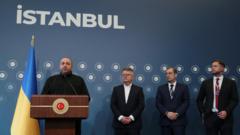The military conflict between India and Pakistan has rapidly expanded beyond their disputed Kashmir border, with deadly airstrikes and artillery attacks claiming civilian lives. The situation is exacerbated by the use of drones and a complex web of disinformation, raising fears of a wider war. Diplomatic efforts are underway to deescalate tensions, but the threat of further hostilities looms large.
Escalation of India-Pakistan Conflict Poses Grave Risks as Hostilities Intensify

Escalation of India-Pakistan Conflict Poses Grave Risks as Hostilities Intensify
A deepening military confrontation between India and Pakistan marks one of the most critical escalations in decades, following deadly attacks and widespread violence.
In a troubling escalation of military hostilities, tensions between India and Pakistan have flared significantly, marking one of the most intense confrontations between the two nations in decades. This escalation follows a series of Indian airstrikes that targeted locations within Pakistan and the Pakistani-controlled region of Kashmir, after a terrorist attack on Indian tourists that left 26 dead on April 22.
Reports from Friday revealed that both countries have been exchanging fire well beyond the contested Kashmir region, expanding the scope of their military operations. The Indian Army announced that it intercepted drone attacks launched by Pakistan, which Pakistan has vehemently denied. Observers noted the newfound reliance on drone technology in the conflict, a departure from traditional combat methods used in previous encounters.
As both nations returned fire across the Line of Control, civilians on both sides became casualties of the conflict. This confrontation is notably reminiscent of periods of intense conflict, recalling fears and blackouts experienced during prior wars, particularly the 1971 conflict.
The political climate is troubled further by a thickening fog of misinformation, with both nations controlling narratives through state broadcasts and social media. India has limited access to Pakistani news channels, while Pakistan has continued to restrict Indian media coverage.
In addition to military strains, diplomatic channels remain active, with reports of communication between officials from both countries and intermediaries from allied nations. However, the potential for miscalculation and further violence remains high, as populist sentiments in both countries intensify.
The international community watches closely, aware of the nuclear capabilities possessed by both nations. Any further escalation holds the potential for catastrophic consequences, raising alarms reminiscent of past conflicts.
With schools across regions affected by the conflict closing their doors and residents issued warnings to seek shelter, the heightened sense of fear extends throughout the population, as families stockpile supplies and prepare for the worst amid a tumultuous and evolving security landscape.
Reports from Friday revealed that both countries have been exchanging fire well beyond the contested Kashmir region, expanding the scope of their military operations. The Indian Army announced that it intercepted drone attacks launched by Pakistan, which Pakistan has vehemently denied. Observers noted the newfound reliance on drone technology in the conflict, a departure from traditional combat methods used in previous encounters.
As both nations returned fire across the Line of Control, civilians on both sides became casualties of the conflict. This confrontation is notably reminiscent of periods of intense conflict, recalling fears and blackouts experienced during prior wars, particularly the 1971 conflict.
The political climate is troubled further by a thickening fog of misinformation, with both nations controlling narratives through state broadcasts and social media. India has limited access to Pakistani news channels, while Pakistan has continued to restrict Indian media coverage.
In addition to military strains, diplomatic channels remain active, with reports of communication between officials from both countries and intermediaries from allied nations. However, the potential for miscalculation and further violence remains high, as populist sentiments in both countries intensify.
The international community watches closely, aware of the nuclear capabilities possessed by both nations. Any further escalation holds the potential for catastrophic consequences, raising alarms reminiscent of past conflicts.
With schools across regions affected by the conflict closing their doors and residents issued warnings to seek shelter, the heightened sense of fear extends throughout the population, as families stockpile supplies and prepare for the worst amid a tumultuous and evolving security landscape.





















